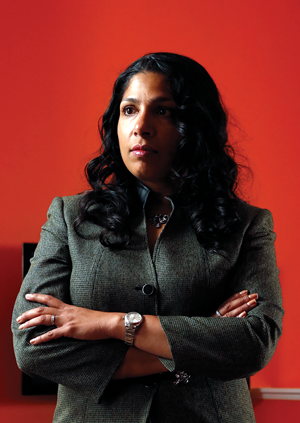How can barriers to advancement be removed for women at large law firms?

Arin Reeves. Photo by Wayne Slezak.
On a late October day in New York City, partners, law firm associates and in-house counsel gathered at the offices of Mayer Brown to confront issues of gender inequity in BigLaw and brainstorm ways to move the needle.
The discussion happened at a time when the state of diversity in the legal profession is sobering at best and dismal at worst, according to members of the panel brought together to address the issue.
Survey findings released by the New York City Bar Association, for example, indicated that, while women have made some gains at the 75 law firms that responded to the survey, the percentage of female first-year associates at the firms in 2015 was 45.2 percent, a decrease of five percentage points since 2004. The finding “raises concerns about erosion of the associate pipeline,” the report stated.
The survey further found that 35 percent of all lawyers at the firms in 2015 were women, “despite representing almost half of graduating law school classes for nearly two decades.” The survey found that 18.4 percent of women and 20.8 percent of minorities left the surveyed firms in 2015, compared to an attrition rate of 12.9 percent for white men, who accounted for 77 percent of equity partners.
Another recent study by Major, Lindsey & Africa, a legal recruiting firm headquartered in Chicago, found that male partners make 44 percent more on average than female partners make.
The title of the event at Mayer Brown—“Visible Difference: Reversing the Trend of Women Leaving Law Practice”—succinctly stated the dilemma. The program focused on best practices—what’s working and what isn’t—against a backdrop of recent class action lawsuits filed by female partners and recent reports of pay disparities and lack of diversity in large law firms. The ABA Journal partnered with Mayer Brown to produce the event, which included collaborative panel discussions in Chicago and New York.
“If we had an equal number of women in leadership roles at the firm, we wouldn’t have this problem,” said Mayer Brown partner Lisa M. Ferri, one of the panelists at the program in New York. “When women are on compensation committees, there is less disparity in pay.” The biggest challenge is attrition, she said. “Because of that, we don’t have a pipeline” that leads to partnership.
Ferri suggested that attorneys should get credit for the collaborative ways they serve the firm’s clients and not just for billable hours. She said firms also should find ways to share origination credit.
“There has to be an actual change in the firm or things that stand in the way of succeeding,” she said.
OLD SOLUTIONS AREN’T WORKING
The next level of change is going to require structural change, said Arin N. Reeves, founder and president of Nextions, a research and consulting firm in Chicago. “How can we mentor women better? How can we sponsor women better?” said Reeves, who moderated the New York and Chicago programs. She said her recent research demonstrates that “we don’t need to do anything ‘more’ for women. We need to get out of their way” by removing barriers and challenges.
Gabrielle Lyse Brown, director of diversity and inclusion at the New York City Bar Association, presented data from its new report that showed that one in four New York firms has no women on its management committee, and one in eight has no female practice group leaders. The report also revealed that, of female partners at responding law firms, 85.2 percent were white, 7 percent were Asian or Pacific Islander, 3.6 percent were black, and 2.5 percent were Hispanic.
“Women aren’t monolithic,” Reeves said, noting that women of color face additional hurdles in their advancement. “There are different issues and challenges we face.”
Nate Saint-Victor, an executive director in the legal and compliance division of Morgan Stanley in New York City, noted that racial and gender bias is “still widespread” in corporate legal departments. Saint-Victor said mentoring women of color has been an effective tool. But every attorney in the position to do so has an “obligation to pursue a meritocratic environment within your organization,” he said.
“You can’t be who you can’t see,” said Saint-Victor, explaining that promoting female partners who “aren’t just tokens” can be an inspiration to associates who hope to move up through a firm. Diversity should be a goal in promoting other attorneys, as well, he said.
Adrienne D. Gonzalez of the Black Organization for Leadership and Development’s people and business resource group at Bristol-Myers Squibb said her company partners with law firms to groom diverse lawyers. Bristol-Myers Squibb also has adapted a business model to reflect the country’s changing landscape and promote inclusiveness internally as well as with its outside counsel, she said.
“What we know is that by 2050, this country will be more than 50 percent African-American, Asian-American and Hispanic,” Gonzalez said. “We have to be responsive to the fact that the country is changing. We can’t keep using the same formula; we need to evolve.”
This article originally appeared in the January 2017 issue of the ABA Journal with this headline: "Changing Times: Panelists look for ways to remove barriers to advancement for women at large law firms."
Write a letter to the editor, share a story tip or update, or report an error.


